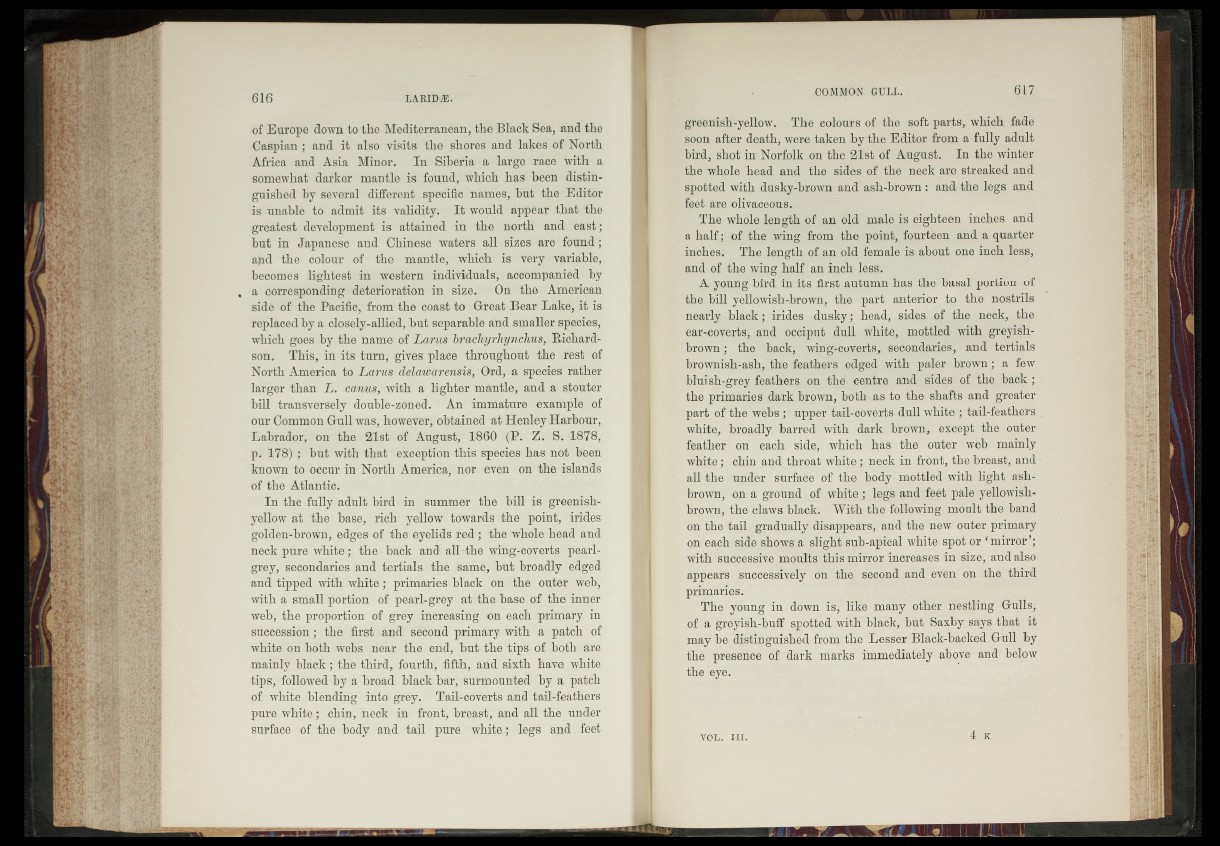
of Europe down to the Mediterranean, the Black Sea, and the
Caspian ; and it also visits the shores and lakes of North
Africa and Asia Minor. In Siberia a -large race with a
somewhat darker mantle is found, which has heen distinguished
by several different specific names, hut the “Editor
is unahle to admit its validity. It would appear that the
greatest development is attained in the north and east;
hut in Japanese and Chinese waters all sizes are found ;
apd the colour of the mantle, which is very variable,
becomes lightest in western individuals, accompanied! by
, a corresponding deterioration in'size. On the American
side of the Pacific, from the coast .to Great Bear Lake, it is
replaced by a closely-allied, but separable and smaller species,
which goes by the name of Lams brachyrhyhehus, Richardson.
This, in its turn,'gives place throughout the resttiof
North America to Larus delaw’arensis, Ord, asSpecies rather
larger than L.4’canus, with a lighter mantle/ and a stouter
bill transversely double-zoned. An immature- example, of
our Common Gull was, however, obtained at Henley Harbour,
Labrador, on the- 21st of August, Z. S. 1%?$,
p. 178) :; but with that" eieeption tMs?%peeies' has not been
known to occur in Norths^America, nor . even on the islands
of the Atlantic.- É
In the fully adult" bird in summer the.a-M^L';^:#? greenish-
yellow at the base, rich yellow** towards thé point, brides
golden-brown, edges of the eyelids red ;.the wholé head and
neck pure white/; the back and all-the wing-coverts -pearl-
grey, secondaries and tertials -the Same, but broadly ifflged
and tipped with white £ pn&nkries black'ondhe outer web,
with a small portion | of pearl-grey at the base of the inner
web, the proportiorr/of grey increasing on-each primary in
succession ; • » the/first and second priinary with a patch - óf
white'on both -webs near the - ënd,. büt the tips of: both: are
mainly black ; the'third, 'fourth* fifth, and sixth have,,white
tips, followed by a broad black bar, surmounted "by a patch
of . white blending fitfi grey. Tail-coverts and tail-feathers
pure white; chin, -neck ifi front* breast, and- al-lrthé under
surface of thë body and tail pure white; - legs and feet
greenish-yellow. The colours of the soft parts, which fade
soon after death, were taken by the Editor from a fully adult
bird-, shot in Norfolk on the 21st of August. In the winter
the whole head and the sides of the neck are streaked and
spotted with, dusky-brown and ash-brown : and the legs and
feet are olivaceous*,
The;,:Whole length of an old male is gightee;n^|uches and
a half; of the wing from the point, fourteen and a quarter
inches. The length of an oldfbmale is about one inch less,
and of-thawing half an inch less.
A yoppg bird in its first autumn has the basal portion of
the bill ypfqwlsh-hrown^ th e p a rt anterior „to the nostrils
nearly b(l|g k ; .ij;idg^.dusb y ? head, sides of the neck, Hie
ear-coverts, .and occiput- dull white, mottled with greyish-
brown ; th e back» wing-coverts, secondaries, and tertials
brownish-ash, thg feathers edged with paler brown; a few
bluish-grey Jgatherg on -thg/iCgntre and sides of the back ;
th e primaries dark brown, both as to the shaft's and grdatef,
part of th e w ebs; upper tail-covefts dull Whtfte-*; tail-feathers
white, broadly barred with dark brownA e&ijeff1 the outer
-feather orb ^each:<sidej‘ »which has the outer** web *’ maiMy
white chin and throat whitey neck in front, the breast, and
all the- under surface of l?|ie^hddy^ mot.tj.ed with light as]a-
hrow-n, on a g-rounjj j of white ; legs and |@§t pale yellowish-
brown, the claws black, With the following moult the band
on the tail gradually, disappears, and- the’’ new outer primary
o%aa*p§sjde ydi®pg;a p||ght sub-apical whifespot or ‘ mirror*;
With rsuecessiveimoults this mirror increase's'''in sizfe’,'and also
appears /successively^ of? the4 .second and SgVgn'’on_fhe third
primaries.
f®|eSy6ung. In down is jT p e many other nestling Gulls;
off4y^re^ih'-buff spotted Wraf hlack, but Saxby says th a t' ‘it*
may be distinguished from the "Les.ser Black-backed Gull by
the presence 'of'dark marks immediately above and*' below
the -eyef*^
am p rit. mm